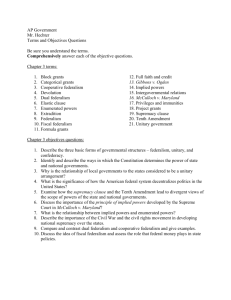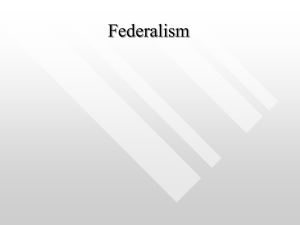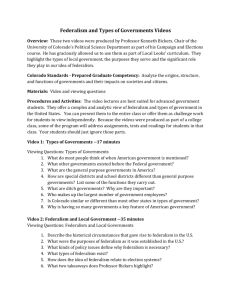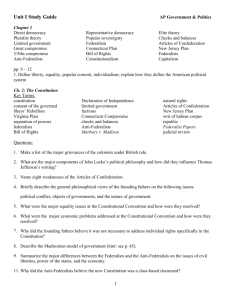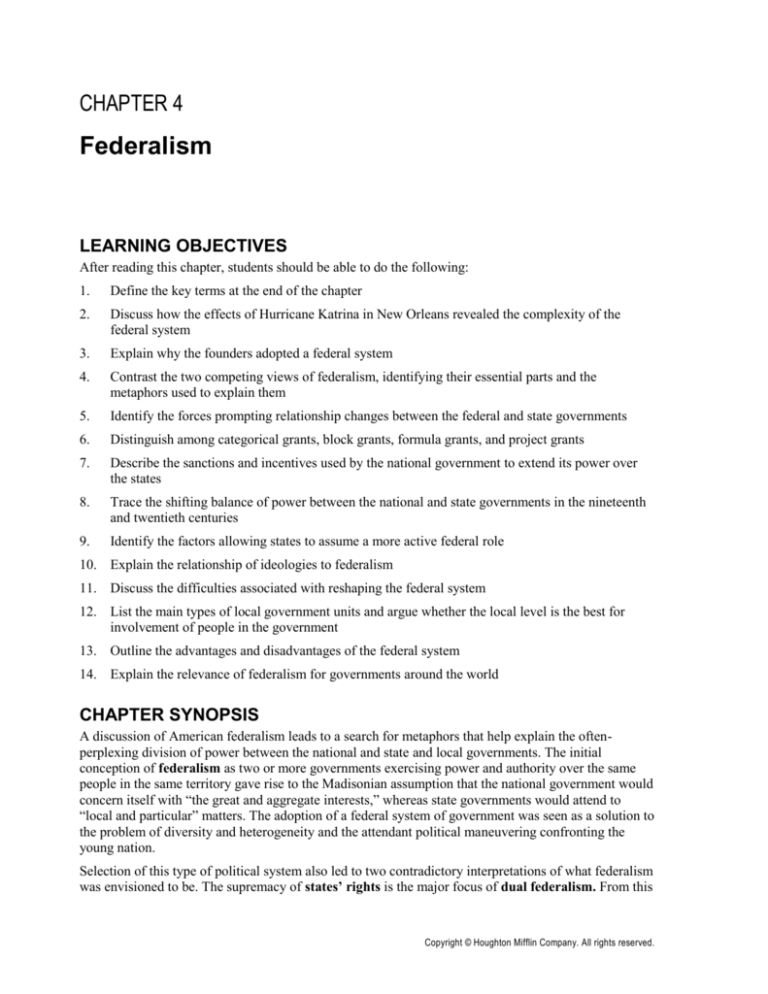
CHAPTER 4
Federalism
LEARNING OBJECTIVES
After reading this chapter, students should be able to do the following:
1.
Define the key terms at the end of the chapter
2.
Discuss how the effects of Hurricane Katrina in New Orleans revealed the complexity of the
federal system
3.
Explain why the founders adopted a federal system
4.
Contrast the two competing views of federalism, identifying their essential parts and the
metaphors used to explain them
5.
Identify the forces prompting relationship changes between the federal and state governments
6.
Distinguish among categorical grants, block grants, formula grants, and project grants
7.
Describe the sanctions and incentives used by the national government to extend its power over
the states
8.
Trace the shifting balance of power between the national and state governments in the nineteenth
and twentieth centuries
9.
Identify the factors allowing states to assume a more active federal role
10. Explain the relationship of ideologies to federalism
11. Discuss the difficulties associated with reshaping the federal system
12. List the main types of local government units and argue whether the local level is the best for
involvement of people in the government
13. Outline the advantages and disadvantages of the federal system
14. Explain the relevance of federalism for governments around the world
CHAPTER SYNOPSIS
A discussion of American federalism leads to a search for metaphors that help explain the oftenperplexing division of power between the national and state and local governments. The initial
conception of federalism as two or more governments exercising power and authority over the same
people in the same territory gave rise to the Madisonian assumption that the national government would
concern itself with “the great and aggregate interests,” whereas state governments would attend to
“local and particular” matters. The adoption of a federal system of government was seen as a solution to
the problem of diversity and heterogeneity and the attendant political maneuvering confronting the
young nation.
Selection of this type of political system also led to two contradictory interpretations of what federalism
was envisioned to be. The supremacy of states’ rights is the major focus of dual federalism. From this
Copyright © Houghton Mifflin Company. All rights reserved.
Chapter 4: Federalism
45
perspective, the Constitution is a compact between sovereign states. Dual federalism views states as
powerful components of the federal system. The two levels of government operate on different tracks,
and each is in control of its own activities. From the perspective of cooperative federalism, the
Constitution represents an agreement made by the people, who are citizens of both the state and the
nation. This view of federalism envisions the states and the national government as intertwined, rather
than as acting in separate spheres.
The constitutional sections that ignite the federalism debate are Article I, Section 8, which enumerates
the powers allotted to Congress and includes the necessary and proper, or elastic, clause, and the Tenth
Amendment, which says that “powers not delegated to the United States by the Constitution, nor
prohibited by it to the States, are reserved to the States respectively, or to the people.” It is from the
elastic clause that the concept of implied powers—those powers not spelled out, but expected to be
asserted by the national government to carry out its enumerated responsibilities—was derived. This
clause has been defended as essential because the framers of the Constitution could not anticipate all
the powers needed by a new nation and its government. States’ rights advocates interpreted the Tenth
Amendment as placing firm limits on the scope of the national government.
An analysis of federalism that focuses primarily on formal constitutional authority would be
misleading, because the actual balance between national and state powers has always been largely a
matter of practical politics. The national government has assumed a far greater role than early
politicians would ever have imagined. This shift of power has come about through national crises and
demands, judicial interpretations, the expansion of grants-in-aid, and the professionalization of state
governments.
Conventionally championed by conservatives, federalism typically includes increased state
experimentation with problems, a belief aligned with dual federalism. Liberals have been associated
more closely with increased federal involvement to solve dilemmas and inequities between states,
central to cooperative federalism. However, these stereotypical characterizations underestimate that it
is probably a combination of the ideology and particular situation, not so much simply the ideology or
precedent that defines the type of federalism used to resolve the problem.
In recent years, both Republican and Democratic presidents have come into office promising to reduce
the federal bureaucracy and return power to the states. However, despite presidential promises,
Congress continues to place demands on states and localities. Under the powers of preemption,
Congress enacts laws that encroach upon state authority. Through both mandates (funded and
unfunded) and restraints, Congress can require states to accept its decisions. This, when combined
with earlier comments about grant use, may lend analysis to a new federalism model.
The idea of federalism has become increasingly important as more sovereign nations enter into
federalist arrangements (e.g., the European Union). Such unions present opportunities to overcome
long-held differences, but such entities struggle—as the early U.S. did—to decide how to best divide
power among the union government and the individual nations.
PARALLEL LECTURE 4.1
I.
Federalism: definitions and theoretical perspectives
A. Federalism: the division of power between a central government and regional governments.
1. In the United States, government power is divided between the national government
and the states.
2. Citizens feared that without a federal system, they would be ruled by majorities with
different interests and values.
B. Dual federalism
Copyright © Houghton Mifflin Company. All rights reserved.
46
Chapter 4: Federalism
1.
II.
Dual federalism: a view that holds that the Constitution is a compact among sovereign
states, so that the powers of the national government and the states are clearly
differentiated (represented by the layer-cake metaphor).
a) States are, in some ways, equal to the federal government.
b) States’ rights: the idea that all rights not specifically conferred on the national
government by the U.S. Constitution are reserved to the states.
c) The national government rules by enumerated powers only (supported by the
Tenth Amendment).
d) Dual federalism has been challenged on historical grounds.
e) The role of the people is not clear in the dual federalism perspective.
2. Cooperative federalism: a view that holds that the Constitution is an agreement
among people who are citizens of both state and nation, so there is much overlap
between state powers and national powers (represented by the marble-cake metaphor).
a) National and state governments undertake functions jointly.
b) Nations and states routinely share power.
c) Power is not concentrated at any level of government or in any agency;
fragmentation of responsibilities gives people and groups access to many venues
of influence.
d) Stresses the role of the national government, supported by an expansive view of
the supremacy clause (Article VI)
3. Differences in the theories of dual and cooperative federalism are based in
Constitutional interpretation.
a) The elastic clause (Article I, §8): gives Congress the means to execute its
enumerated powers; and is the basis for Congress’s implied powers (also called
the necessary and proper clause).
(1) Dual federalism postulates an inflexible elastic clause.
(2) Cooperative federalism postulates suppleness in the elastic clause.
b) The Tenth Amendment says that “powers not delegated to the United States by
the Constitution, nor prohibited by it to the States, are reserved to the States
respectively or to the people.”
(1) Dual federalism postulates a capacious Tenth Amendment.
(2) Cooperative federalism confines the Tenth Amendment to a self-evident,
obvious truth.
Federalism’s dynamics
A. The actual and proper balance of power between the nation and the states has always been a
matter of debate.
1. The Constitution’s inherent ambiguities about federalism generate both constraints and
opportunities for politicians, citizens, and interest groups.
2. Both elected and appointed officials often make policy decisions based on pragmatic
considerations without regard to theory.
3. Public problems cut across government boundaries.
B. National crises and demands
1. The elastic clause has increased the scope of the national government in times of crises
and national emergencies.
a) The Great Depression
(1) National government offered money to support state relief efforts, but states
had to provide administrative supervision or additional funds.
(2) National government extended its power and control over the states through
regulations attached to grants.
(3) Significant change in the ways Americans thought about their problems and
the role of the national government in solving them
Copyright © Houghton Mifflin Company. All rights reserved.
Chapter 4: Federalism
b)
C.
D.
47
The attacks of September 11, 2001
(1) Swift expansion of national power through such legislation as the USAPatriot Act
(2) Creation of the Department of Homeland Security, a new department that
united over twenty previously separate federal agencies
2. The national government has also responded to needs the states and localities were
unable or unwilling to meet.
a) The Voting Rights Act of 1965: gives national government officials the power to
decide whether individuals are qualified to vote and requires that qualified
individuals be permitted to vote in national, state, and local elections.
b) Act intrudes on political sovereignty of the states by replacing state officials with
national examiners
c) Constitutional authority rests in the Fifteenth Amendment (§2), which gives the
power to enforce the amendment through “appropriate legislation.”
Judicial interpretation
1. Court settles disputes over the powers of the national and state government by deciding
whether the acts of either are unconstitutional
a) In the nineteenth and early twentieth centuries, the Court often decided in favor
the states.
b) 1937–1995: Court tended to support the national government
c) 1995–present: Court has tended to favor states rights, but not without exceptions
2. McCulloch v. Maryland adopted a broad interpretation of the elastic clause
3. The commerce clause: the third clause of Article I, §8 of the Constitution, which gives
Congress the power to regulate commerce among the states.
a) The Court’s interpretation of this clause has been a major factor in increasing or
decreasing the national government’s power.
b) Gibbons v. Ogden (1824): broad interpretation of commerce; increased national
government power
c) Dred Scott (1857): Congress had no power to prohibit slavery in the territories;
narrow interpretation of commerce; increased state government power
d) 1937: Court upholds FDR’s New Deal legislation; increased national government
power
e) United States v. Lopez (1995): held that Congress exceeded its authority under
the commerce clause in regard to legislation banning guns in school zones;
increased state power
f)
Printz v. United States (1997): Court concluded that Congress could not require
states to implement a regulatory scheme imposed by the national government;
increased state power
4. Shifting scales?
a) Bush v. Gore (2000): Court ordered halt to Florida ballot recounts, overruling the
Florida courts
b) Ruled Texas law banning homosexual conduct between consenting adult was
unconstitutional (2003)
Grants-in-Aid
1. Grant-in-aid: money paid by one level of government to another level, to be spent for
a specific purpose.
a) Categorical grants: grants-in-aid targeted for a specific purpose by either
formula or project.
(1) Formula grants: categorical grants distributed according to a particular set
of rules, called a formula, that specifies who is eligible for the grants and
how much each eligible applicant will receive.
Copyright © Houghton Mifflin Company. All rights reserved.
48
Chapter 4: Federalism
(2)
Project grants: categorical grants awarded on the basis of competitive
applications submitted by prospective recipients to perform a specific task
or functions.
(3) Categorical grants tend to increase national power and decrease state power.
b) Block grants: grants-in-aid awarded for general purposes, allowing the recipient
great discretion in spending the grant money.
2. Grants-in-aid are a method of redistributing income, and reducing gross inequalities
among states and their residents.
3. Grant money always comes with strings attached.
a) Define what the money must be used for.
b) Require the states to evaluate how well the grant is working.
c) The national government may use grants to achieve some broad national goal that
is not necessarily closely related to the specific purpose of the grant (e.g.,
highway funds and the drinking age).
E. Professionalization of state governments
1. Since the 1960s, states have become more capable and forceful policy actors.
a) Governors and legislators employ better trained and more experienced policy
staff.
b) Legislative sessions are longer and legislators receive higher salaries.
c) More highly qualified people are running for state office.
d) States have increased ability to raise revenue.
e) Bureaucrats are generally more highly educated.
2. Changes in national policy have also helped the states to develop.
a) Many grants-in-aid include capacity-building elements.
b) Example: the Elementary and Secondary Education Act catalyzed changes that
improved states’ ability to make and administer education policy
III. Ideology, policymaking and American federalism.
A. Policy entrepreneurs: citizens, members of interest groups, or public officials who
champion particular policy ideas.
1. Federalism offers policy entrepreneurs myriad opportunities to influence politics and
policy.
2. The most creative entrepreneurs can work at multiple levels of government
simultaneously.
B. Ideology, policymaking, and federalism in theory
1. Conservatives are often associated with dual federalism.
2. Liberals are often associated with cooperative federalism.
3. Presidential actions since the 1960s seem to support these generalizations.
a) Lyndon Johnson: liberal; Great Society is often characterized as apex of national
government activism
b) Richard Nixon: conservative; New Federalism call for block grants to return
power to the states
c) Jimmy Carter: liberal; did not support the block grant approach
d) Ronald Reagan: conservative; sought to “restore a proper constitutional
relationship” between the national government and the states
e) Bill Clinton: liberal; saw more potential for national government to produce
policy success
f)
George W. Bush: conservative; sought to embrace states’ rights in a tempered
fashion
C. Ideology, policymaking, and federalism in practice
1. Preemption: the power of Congress to enact laws by which the national government
assumes total or partial responsibility for a state government function.
Copyright © Houghton Mifflin Company. All rights reserved.
Chapter 4: Federalism
a)
49
Preemption is a modern function; a majority of all preemptive acts was passed
between 1970 and 1990.
b) Example: The Nutrition Labeling and Education Act of 1990
c) Types of preemption
(1) Mandate: a requirement that a state undertake an activity or provide a
service, in keeping with minimum national standards.
(2) Restraint: a requirement laid down by act of Congress, prohibiting a state
or local government from exercising a certain power.
d) Preemption costs state and local governments money and interferes with their
ability to set priorities.
e) Use of unfunded mandates was constrained by the Unfunded Mandates Relief
Act of 1995
(1) Required cost analysis of legislation
(2) Required Congress to hold a separate vote specifically imposing a
requirement on other governments without providing money to fulfill that
requirement.
2. Liberal or conservative support for mandates tends to depend on the ideology and the
purpose of government being considered
a) Ronald Reagan’s administration was less likely than Bill Clinton’s administration
to support state interests in cases appearing before the Supreme Court.
b) Conservatives may be less likely to support the states when the states’
relationship to business is adversarial.
c) Federalism tends to be a secondary value, and is overshadowed by other primary
values.
IV. Federalism and Electoral Politics
A. National capital-state capital links
1. State capitals often serve as proving grounds for politicians who aspire to national
office.
2. Four of the last five presidents served as governors to their states.
3. State campaign experience is very important in mounting a successful campaign for
national office.
a) Experience builds networks and fundraising potential for national races.
b) State experience allows the candidate to acquire a network of other state contacts.
B. Congressional redistricting
1. Redistricting: the process of redrawing political boundaries to reflect changes in
population.
2. Congressional districts are typically drawn by state legislatures.
3. Preclearance of potential district designs in some states by the U.S. Justice
Department also highlights the link between the national and the state governments.
V. Federalism and the American intergovernmental system
A. Thousands of governments
1. There is 1 national government, 50 state governments, and more than 87,500 local
governments of various types.
2. Types of local governments
a) Municipal governments: the government units that administer a city or town.
a) County governments: the government units that administer a county.
b) School districts: the government unit that administers elementary and secondary
school programs.
c) Special districts: government units created to perform particular functions,
especially when those functions are best performed across jurisdictional
boundaries.
Copyright © Houghton Mifflin Company. All rights reserved.
50
Chapter 4: Federalism
3.
4.
Home rule: the right to enact and enforce legislation locally.
Theoretical advantages of localized government
a) Brings government closer to the people
b) Provides opportunity to participate in political process
c) Appears compatible with majoritarian model
5. Reality of local government
a) People are less likely to vote in local elections than national elections.
b) Fragmentation makes government seem complicated—complexity encourages
pluralism.
B. Crosscutting responsibilities
1. Public demands for better services caused many states to raise taxes during the late
1990s and the early twenty-first century.
2. Crises (e.g., the Washington, DC, sniper incident) may reveal overlapping
responsibilities and jurisdictions.
VI. Federalism and the international system
A. American federalism and world politics
1. Trade policy is an example of how federalism impacts on international relationships.
2. The Constitution provides the national government, but not the states, with justification
and formal authority in the area of trade.
3. But state leaders do develop and advance their own trade agendas
a) Thirty-eight states employ international trade directors.
b) The State International Development Organizations coordinate state trade
activities and lobby the U.S. Department of Commerce.
c) A small number of state and local jurisdictions also advance their international
human rights positions.
B. Federalism across the globe
1. Among the 195 nations in the world, 25 of these are federations containing about 40
percent of the world’s population.
2. The European Union is an example of this pattern
VII. Federalism and pluralism
A. Constitution gives “great and aggregate” matters to the national government, and “local and
particular concerns” to the states
B. Federalism recognizes the legitimacy of states as political units.
C. These political divisions are an acknowledgment of diversity.
D. The two competing theories of federalism support pluralism.
1. Dual federalism provides states with a buffer against the national government.
2. Cooperative federalism is more amenable to national prerogatives, but is also highly
responsive to all manner of pressures from groups and individuals.
FOCUS LECTURE 4.1: AN INTERACTIVE LECTURE
How Federalism Affects Us
This lecture attempts to make the chapter come into focus for students. Before presenting this lecture,
you should remind students that you are doing something that requires their active participation during
class. Remind them that they must read the chapter in advance and that they will need to bring the text
to class for reference.
I.
Ask students to define (by reading from the text, if necessary) the following terms:
A. Federalism
B. States’ rights
Copyright © Houghton Mifflin Company. All rights reserved.
Chapter 4: Federalism
51
C.
Marble-cake and layer-cake federalism (Encourage students to go to the board and draw an
illustration of these systems of federalism.)
D. Preemption (mandates and restraints)
II. Ask whether any students are from other countries; if so, have them comment on their nation’s
way of handling these issues.
A. If any student is from a nation with a unitary system, ask the student to describe some
aspects of that system.
B. If any student is from a nation undergoing upheaval, ask the student to describe some of the
consequences of a dysfunctional national government.
C. If there are no international students, be prepared with examples from the news that illustrate
how other nations without federalist arrangements distribute political power.
III. Pick three issues (your choice) to illustrate the dilemmas of federalism.
A. Possibilities include healthcare needs, civil rights, civil liberties, education needs, and so on
(it may be helpful to have prepared news stories to distribute to the class, or to present the
details of specific cases).
B. Ask students to discuss the pros and cons of federal involvement in those areas. (At this
point, you may wish to have students form pairs and share their ideas before the class
reconvenes.) Consider posing the following questions:
1. Should the national government set standards for the nation?
2. What is the proper balance between uniformity and local autonomy?
3. What issues should be locally determined?
4. What issues require national legislation and enforcement?
5. How does the United States compare with other nations in terms of these allocations of
responsibility?
(Note: It is not the purpose of the interactive lecture to develop uniformity of thinking; its purpose is to
develop active learning and appreciation for diversity of opinion.)
INTERACTIVE MEDIA LECTURE 4.1: JERRY SEINFELD AND THE
FEDERALIST DILEMMA
It’s Really Nothing… But It Could Land You in Jail
This presentation highlights the (rather rare) use of federalism in the popular media. Encourage your
students to share any other media examples of federalism they might think of, as well.
The first half of the series finale of Seinfeld, “the show about nothing,” featured the group (Jerry,
George, Elaine, and Kramer) taking a private plane to Paris. After the plane starts to go into a crash
dive, but then rights itself, the crew lands in Latham, Massachusetts, for the plane to be checked before
it continues on to Paris. While in Latham, they witness the robbery of an overweight man, which they
all mock and Kramer videotapes. They are arrested under the Good Samaritan law established by the
town. The rest of the episode (both parts) is their trial (and eventual conviction) for breaking that law.
Depending on time constraints, show either the last half of the first finale episode, or the episode in its
entirety. Then direct the discussion with questions that address the following issues:
Which theory of federalism is implicitly referenced in this episode?
Could this situation have occurred under a unitary system?
Is this a fair representation of how federalism actually works in the United States?
“Local standards” and “diversity” are a very important part of the idea of states rights, but
are they fair in this case?
Copyright © Houghton Mifflin Company. All rights reserved.
52
Chapter 4: Federalism
Is it ever fair to hold visitors to local laws and/or standards of conduct? If not, then is
federalism really a sufficient method for maintaining diversity?
PROJECTS, ACTIVITIES, AND SMALL-GROUP ACTIVITIES
1.
Do a brainstorming session with the class on the following topic: What areas of American life are
governed differently from state to state? (You might survey the class first to see which students
have lived in other states; they are good resource people for this discussion.) You can stimulate
thinking by giving examples such as marriage and divorce laws, adoption laws, euthanasia laws,
minimum education requirements, and licensing of professions and occupations. When the list has
been developed, ask students to discuss each item from the perspective of evaluating whether this
area of law should be national. Ask students for examples of some problems that have occurred
due to lack of uniformity in such laws, such as the Dr. Kevorkian euthanasia debate. Let students
develop their views on the complexity of federalism by focusing on issues they may have heard
about because of mass media coverage.
2.
Direct your students to the website www.urban.org/PERIODCL/pubsect/derthick.htm, where
Martha Derthick, noted political scientist and author of the essay “Whither Federalism”
contemplates the future of intergovernmental relations. Derthick argues that despite recent efforts
at devolution, it is “much too early to conclude that the trend toward centralization is being
reversed.” To support this claim, Derthick argues that less and less consideration is being given to
geography in making appointments to high political offices (such as the Supreme Court and the
cabinet).
Use Derthick’s example to generate class discussion. Should the Supreme Court, the cabinet, and
federal agencies be geographically representative? What benefits and disadvantages would ensue
if that were the case? What is gained by not having geographical representation in such offices? Is
it preferable to have better gender and racial representation, even if it is at the expense of
geographical representation? Does geographical representation in high appointive offices really
matter, given that representation in Congress is geographically based?
3.
Have students form small groups. Ask each group to think of a local problem in their community
and to develop an action plan to solve that problem. Ask them to evaluate whether their problem
can be solved only through local government or whether it requires state or federal involvement.
Circulate through the room and assist students with this assignment; your goal is to help them
realize how interdependent the levels of government are and how a “local” problem can often
require state or federal intervention. Examples might include poor public transportation, day
laborers congregating in local communities, an outbreak of measles due to lack of immunization,
a high rate of drug use among teens, a graffiti epidemic, and so on.
4.
Use Compared with What? 4.1 to create a discussion. Have students form small groups, and give
them about fifteen minutes to answer the following: What issues divide people living in the same
nation? What are some current situations, either from the text or in the news, that remind us of the
complexities of creating a unified nation? What forces unite a nation? What forces create
divisions? What can “ordinary people” do to respond to those issues? When the time is up,
reconvene the class. Get responses from each group, and develop a discussion of pluralism versus
majoritarianism relating to the issues of nationalism.
Copyright © Houghton Mifflin Company. All rights reserved.
Chapter 4: Federalism
53
INTERNET RESOURCES
The Federalism Project www.federalismproject.org
Learn how contemporary analysis says federalism’s current balance could be altered.
The Urban Institute’s Study on New Federalism
www.urban.org/Content/Research/NewFederalism/AboutANF/AboutANF.htm
Research providing information on the effects of increased state responsibilities for formerly
national social programs
The National Conference of State Legislatures www.ncsl.org
Learn more about how this organization seeks to ensure state legislatures a strong, cohesive voice
in the federal system.
National Association of State Information Resource Executives www.nascio.org/
Search this clearinghouse for state government information available on the Internet.
Council for State Governments www.csg.org/
Learn more about how this group is promoting the sovereignty of the states.
National Association of Counties www.naco.org
See demographical information on counties nationwide.
National League of Cities www.nlc.org/
Experience the local level of government, their information and issues.
U.S. Conference of Mayors http://usmayors.org/uscm/home.asp
Locate information on cities with populations in excess of thirty thousand, their information and
issues.
Copyright © Houghton Mifflin Company. All rights reserved.






